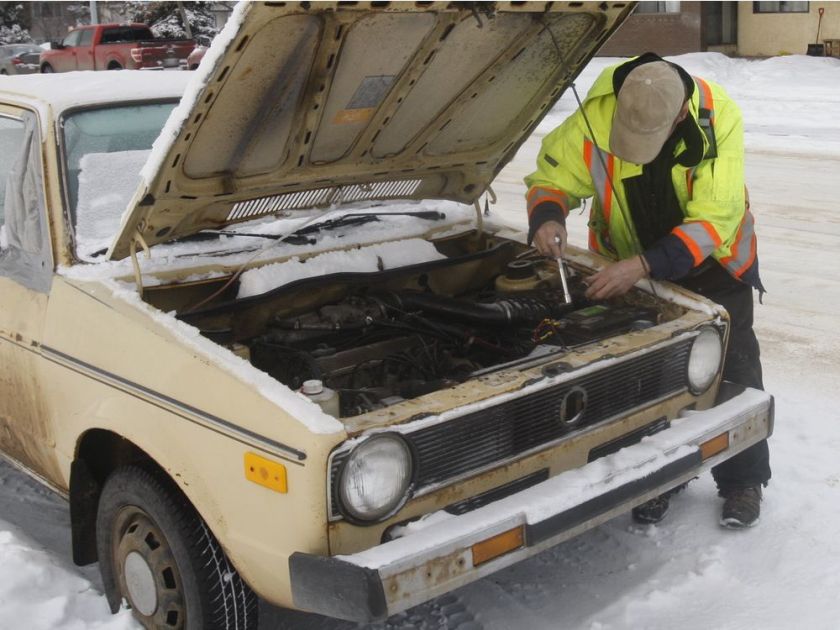People used to be able to get under the hood and fix their cars. But as automobiles become more computerized and complex, tinkering has become a lost art.
Guys love to tinker with things, especially cars.
I recall blissful, if knuckle-skinning, sessions underneath my beloved 1968 VW campervan named George. I could change his oil, check his compression and adjust his valves with my eyes closed. With enough tools and the right manual, I could probably have rebuilt his engine in the middle of the desert, though to be honest I would have been tinkering by trial and error.
As Annie Murphy Paul writes on her Psychology Today blog, “Tinkering is the polar opposite of the test-driven, results-oriented approach of No Child Left Behind: it involves a loose process of trying things out, seeing what happens, reflecting and evaluating, and trying again.”
She goes on to quote a speech by Sylvia Martinez at a meeting of the National Council of Women in Information Technology: “Tinkering is the way that real science happens, in all its messy glory.”
For 25 years, I had the privilege of teaching in Shad Valley Calgary, a wonderful program for highly gifted Canadian teenagers. Each week, we offered them a choice of hands-on seminars on science, math and entrepreneurship. Way back in the 1980s, I was teaching students how to build artificial neural networks and simulate road traffic patterns.
The most popular Shad Valley seminar was given by a graduate student. He took the students outside and taught them practical skills like changing a tire and crafting chain mail armour. While they excelled in their schools, these young folks were often shielded from the hands-on aspects of life. Well-meaning parents bought them piano lessons or enrolled them in university courses, but our Shad students, guys and girls, had a real longing for practical, guided tinkering.
Why is there a looming crisis in tinkering? Have you looked under the hood of a Tesla Model S? There’s a “frunk” (front trunk) where the engine should be! I’m sure there are things an owner can do to help maintain this vehicle, but they’ll be accomplished by tapping on a touch screen. Approaching your Tesla with pliers and a screwdriver is a recipe for disaster.
There’s another problem with trying to tinker with modern vehicles — they’re too smart for us, and I don’t just mean by requiring computers to read their codes. I just tackled the simple task of replacing a rear wiper motor on my 2009 Pontiac Torrent. I put the new one in, hit the switch, and — nothing. I had to consult an obscure car repair forum to learn that “of course the rear wiper is inoperative when the lift gate is open.” I closed the hatch and solved the problem, feeling pretty dopey in the process.
Even worse, a rental car in San Francisco simply would not let me close the trunk at a gas station. It just kept popping open. Embarrassed, I dug out the owner’s manual which, on page 571, explained that “for your protection, you cannot lock the trunk if the key fob is inside.” Of course, there it was, inside my jacket in the trunk.
One of the reasons I’m thinking about this now is that I’m giving the keynote speech to a conference of Science and Technology educators in Calgary on Feb. 26 (information is at https://www.stanrsst.ca/conference — you should consider attending.)
What will I tell them?
Firstly, a reminder that many of the things we enjoy everyday are the result of fiddling around. Steve Jobs was a notorious tinkerer, as were Benjamin Franklin and Nicola Tesla. And then a challenge — to find a way to bring this mindset back for a generation that doesn’t have the thrill of putting together a Heathkit ham radio and travelling the world, analogue-style.
I have a few ideas about how to accomplish this.
Learning to write computer code is a good start, since you almost always have to tinker to get it to work. For those looking for a more physical experience, drop by your local “maker space” and see if someone can point you in the right direction. Or order a Hackerbox. I’m currently building their kit #0026 which contains OpAmps, an Arduino Nano V3, physiological sensors and related gear.
If I follow the instructions correctly, then fool around a bit, this pile of parts should turn into a device capable of “measuring physiological signals of the human heart, brain, and skeletal muscles” — a bargain basement Fitbit with even more functionality. There’s even a subscription service from hackerboxes.com that sends you a new challenge each month.
My point is that we may have a look a bit harder to find opportunities to tinker, for ourselves and those we care about. While our next car may be virtually consumer-proof, everybody has things around the house that go kaput and are usually discarded. YouTube and other websites are chock full of helpful (and unhelpful) fix it yourself videos.
It’s not really that important if that broken coffee pot ever brews another cup, or the windshield wiper motor actually moves. The fun, and the learning, comes from the tinkering journey.
Dr. Tom Keenan is an award-winning journalist, public speaker, professor in the School of Architecture, Planning and Landscape at the University of Calgary, and author of the bestselling book, Technocreep: The Surrender of Privacy and the Capitalization of Intimacy.
